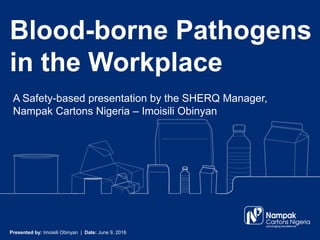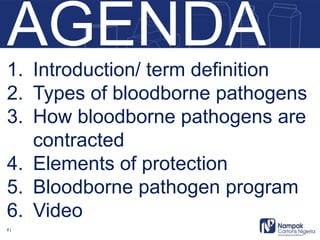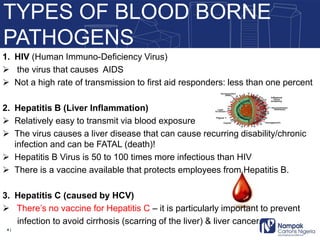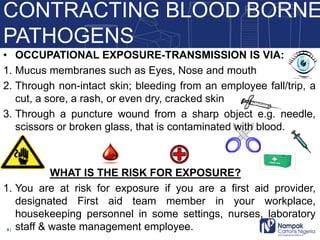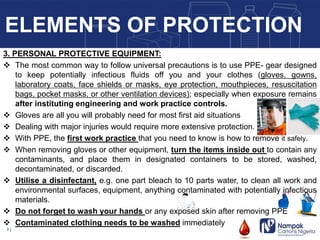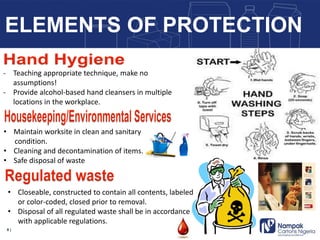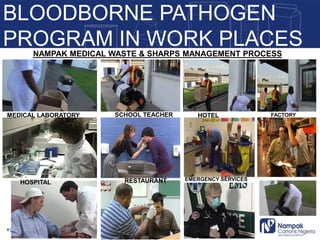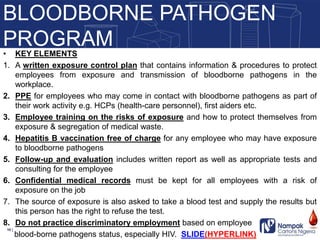Nampak NISCN Presentation 090616
- 1. Blood-borne Pathogens in the Workplace A Safety-based presentation by the SHERQ Manager, Nampak Cartons Nigeria ŌĆō Imoisili Obinyan Presented by: Imoisili Obinyan | Date: June 9, 2016
- 2. AGENDA 2 | 1. Introduction/ term definition 2. Types of bloodborne pathogens 3. How bloodborne pathogens are contracted 4. Elements of protection 5. Bloodborne pathogen program 6. Video
- 3. ŌĆó ThereŌĆÖs the potential when you help someone whoŌĆÖs injured that you could be exposed to something nasty; an infectious disease. ŌĆó It is therefore important to be aware of what bloodborne pathogens are, how they are transmitted & how to protect yourself from them in the workplace. INTRODUCTION 3 | DEFINITION: Bloodborne pathogens are infectious micro-organisms in human blood and body fluids (OPIMs ŌĆō Other potentially infectious materials) that can cause diseases in humans e.g. viruses & bacteria
- 4. 1. HIV (Human Immuno-Deficiency Virus) ’āś the virus that causes AIDS ’āś Not a high rate of transmission to first aid responders: less than one percent 2. Hepatitis B (Liver Inflammation) ’āś Relatively easy to transmit via blood exposure ’āś The virus causes a liver disease that can cause recurring disability/chronic infection and can be FATAL (death)! ’āś Hepatitis B Virus is 50 to 100 times more infectious than HIV ’āś There is a vaccine available that protects employees from Hepatitis B. 3. Hepatitis C (caused by HCV) ’āś ThereŌĆÖs no vaccine for Hepatitis C ŌĆō it is particularly important to prevent infection to avoid cirrhosis (scarring of the liver) & liver cancer. TYPES OF BLOOD BORNE PATHOGENS 4 |
- 5. ŌĆó OCCUPATIONAL EXPOSURE-TRANSMISSION IS VIA: 1. Mucus membranes such as Eyes, Nose and mouth 2. Through non-intact skin; bleeding from an employee fall/trip, a cut, a sore, a rash, or even dry, cracked skin 3. Through a puncture wound from a sharp object e.g. needle, scissors or broken glass, that is contaminated with blood. WHAT IS THE RISK FOR EXPOSURE? 1. You are at risk for exposure if you are a first aid provider, designated First aid team member in your workplace, housekeeping personnel in some settings, nurses, laboratory staff & waste management employee. CONTRACTING BLOOD BORNE PATHOGENS 5 |
- 6. ŌĆó The three main elements of protection are: 1. Awareness/ Enlightenment 2. Engineering and Work Practice controls 3. Personal Protective Equipment 1. AWARENESS (UNIVERSAL PRECAUTIONS): ’üČ the best way to protect yourself from those risks is by following a concept called universal (STANDARD) precautions (this means that you assume that all human blood and body fluids are infectious and avoid same by utilizing non-porous material e.g. medical gloves, goggles, and face shields to protect self. ’üČ If someone is injured in the workplace, use universal precautions to protect yourself before you help someone else, regardless of how well you know them 2. ENGINEERING & WORK PRACTICE CONTROLS: eliminate or minimize employee exposure by deploying: ŌĆō Readily accessible hand washing facilities (hands-free faucets). ŌĆō Contaminated sharps management & Contaminated equipment guidelines ( e.g. sterilization) ŌĆō Keeping food and drink out of the work area. ŌĆō Procedures involving blood handling. ELEMENTS OF PROTECTION 6 |
- 7. 3. PERSONAL PROTECTIVE EQUIPMENT: ’üČ The most common way to follow universal precautions is to use PPE- gear designed to keep potentially infectious fluids off you and your clothes (gloves, gowns, laboratory coats, face shields or masks, eye protection, mouthpieces, resuscitation bags, pocket masks, or other ventilation devices); especially when exposure remains after instituting engineering and work practice controls. ’üČ Gloves are all you will probably need for most first aid situations ’üČ Dealing with major injuries would require more extensive protection. ’üČ With PPE, the first work practice that you need to know is how to remove it safely. ’üČ When removing gloves or other equipment, turn the items inside out to contain any contaminants, and place them in designated containers to be stored, washed, decontaminated, or discarded. ’üČ Utilise a disinfectant, e.g. one part bleach to 10 parts water, to clean all work and environmental surfaces, equipment, anything contaminated with potentially infectious materials. ’üČ Do not forget to wash your hands or any exposed skin after removing PPE ’üČ Contaminated clothing needs to be washed immediately 7 | ELEMENTS OF PROTECTION
- 8. 8 | ELEMENTS OF PROTECTION - Teaching appropriate technique, make no assumptions! - Provide alcohol-based hand cleansers in multiple locations in the workplace. ŌĆó Maintain worksite in clean and sanitary condition. ŌĆó Cleaning and decontamination of items. ŌĆó Safe disposal of waste ŌĆó Closeable, constructed to contain all contents, labeled or color-coded, closed prior to removal. ŌĆó Disposal of all regulated waste shall be in accordance with applicable regulations.
- 9. BLOODBORNE PATHOGEN PROGRAM IN WORK PLACES 9 | MEDICAL LABORATORY SCHOOL TEACHER NAMPAK MEDICAL WASTE & SHARPS MANAGEMENT PROCESS HOTEL FACTORY RESTAURANTHOSPITAL EMERGENCY SERVICES
- 10. ŌĆó KEY ELEMENTS 1. A written exposure control plan that contains information & procedures to protect employees from exposure and transmission of bloodborne pathogens in the workplace. 2. PPE for employees who may come in contact with bloodborne pathogens as part of their work activity e.g. HCPs (health-care personnel), first aiders etc. 3. Employee training on the risks of exposure and how to protect themselves from exposure & segregation of medical waste. 4. Hepatitis B vaccination free of charge for any employee who may have exposure to bloodborne pathogens 5. Follow-up and evaluation includes written report as well as appropriate tests and consulting for the employee 6. Confidential medical records must be kept for all employees with a risk of exposure on the job 7. The source of exposure is also asked to take a blood test and supply the results but this person has the right to refuse the test. 8. Do not practice discriminatory employment based on employee blood-borne pathogens status, especially HIV. SLIDE(HYPERLINK) BLOODBORNE PATHOGEN PROGRAM 10 |

